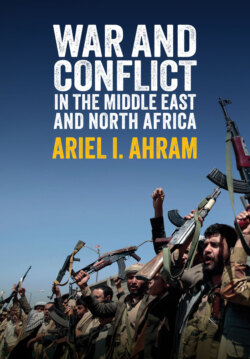Читать книгу War and Conflict in the Middle East and North Africa - Ariel I. Ahram - Страница 11
How to Read This Book
ОглавлениеThis book is intended for students of security studies and Middle East area studies. It explores key thematic issues of war and conflict in MENA using a number of comparative strategies. It is not a comprehensive military history of the region. Certain conflicts get more attention than others. The conflict in Western Sahara, for instance, is mentioned only a few times. The choice to focus on particular episodes of conflict and war is intended to illustrate themes and concepts using historical references that are likely to be familiar to most readers. They are not intended to downplay the importance of any particular conflict. For sourcing, the book largely relies on secondary materials published in English. This is deliberate, in the hopes of encouraging students to use the notes and bibliography for further research. In addition to this narrative element, at numerous points in the book there are graphs and tables that present longitudinal or cross-case comparative information. Again, this is deliberate, intended to demonstrate the value of examining cases of war and violence both intra-regionally within MENA and as part of larger worldwide trends.
Part I of the book sketches the context of conflict and war in the region, testing out the proposition that MENA is exceptionally prone to war. Chapter 1 analyzes different attempts to count and measure the frequency, type, and magnitude of wars in MENA over the last century. It highlights the way MENA diverges from certain global trends and follows others. It highlights the diverse forms of conflict within the region. Chapter 2 provides a conceptual and historical sketch of how the progress of state formation interacted with warfighting. It describes how states and their rivals organized violence differently at different times during the last century. These differences in organization in turn had different ramifications for human security.
Part II examines the elements of the conflict traps that affect MENA. These are not intended as an exhaustive list of war triggers or immediate causes of specific conflicts. Rather, they explore the general conditions that singularly or in combination make war a recurrent and important feature in MENA’s regional affairs. Chapter 3 examines the role of oil in war. It shows that states fighting to control oil markets is relatively rare. However, oil contributes to war and violence largely by affecting the ways states manage and respond to internal opposition and challengers. Chapter 4 examines the role of ethnicity or “ancient hatreds” in regional wars. Finding a common sense of national identity is a crucial component of state-building. But instilling and reproducing this identity often spurs violent resistance. Chapter 5 examines the role of geopolitics and outside intervention in conflict. It shows how outside powers have always played a major role in regional politics, but their ability to spur or restrain conflict has been equivocal. One of the most important elements of geopolitics is not the direct commission of war, but enabling states (and non-state actors) to conduct war on a larger scale.
Chapter 6 offers an extended case study of the last decade of MENA history as a protracted and multi-level regional war. It shows how the civil wars in Libya, Syria, Iraq, and Yemen, often treated as discrete conflicts, became interconnected as theaters in a larger regional and global contest. This contest involved the United States and Russia as the main extra-regional players, but most crucially Iran, Saudi Arabia, Turkey, the UAE, and others as regional actors asserting supremacy. Operating transnationally, the conflict traps escalate war to the point where initial objectives and interests no longer matter.
The seventh and final chapter of the book shifts the focus to peace and peacemaking. There have been innumerable diplomatic plans and efforts to end wars in MENA. Only a fraction have made much impact. Many of these initiatives came from extra-regional powers or their close regional allies. At the same time, “bottom-up” efforts to achieve local conciliation and peace also have a mixed record. This chapter evaluates how different approaches to conflict resolution and mitigation address the potential “traps” of oil, identity, and geopolitics. In many cases, “solving” one trap only exacerbates the problems of the other, creating a Gordian knot that cannot easily be untied. Nevertheless, attention to those places where peace has gained a footing is important for understanding how conflicts in MENA might end.
